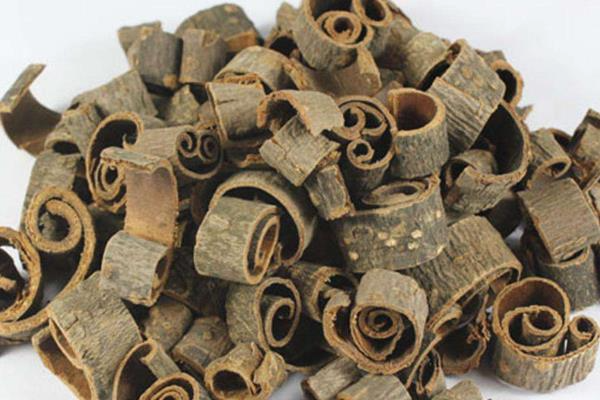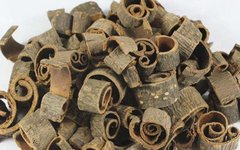Efficacy and Functions
Hou Po (厚朴) refers to the dried bark of the Magnolia officinalis or Magnolia obovata. It has a bitter and pungent taste, is warm in nature, and is associated with the Spleen, Stomach, Lung, and Large Intestine meridians. It has the functions of drying dampness, resolving phlegm, descending Qi to relieve asthma, and promoting the flow of Qi to eliminate stagnation.1. Drying Dampness and Resolving PhlegmHou Po has a bitter taste that can eliminate irritability, and its pungent nature can provide a warming and tonifying effect. It is associated with the Spleen and Stomach meridians, which helps to eliminate internal dampness and phlegm, effectively alleviating symptoms of phlegm-dampness caused by Spleen and Stomach disharmony.2. Descending Qi and Relieving AsthmaWhen combined with Zi Su Zi (紫苏子) and Chen Pi (陈皮), Hou Po can alleviate symptoms of lung Qi stagnation, such as coughing and chest tightness.3. Promoting Qi Flow and Eliminating StagnationDue to its warm nature, Hou Po can promote Qi flow and eliminate stagnation. It is often used in combination with Da Huang (大黄) and Zhi Shi (枳实) to relieve symptoms such as food stagnation, lack of appetite, nausea, pain, and constipation. It is effective for alleviating symptoms of food accumulation and Qi stagnation caused by gastrointestinal dysfunction.
Nutritional Value
Hou Po contains various essential nutrients and beneficial substances. Its active components include magnolol, tetrahydromagnolol, isomagnolol, magnolol phenol, and other compounds.
Suitable for: Individuals with food stagnation and abdominal distension.
Due to its bitter and pungent taste, Hou Po can eliminate irritability, promote Qi flow, and reduce accumulation, making it suitable for patients with food stagnation and abdominal distension.
Contraindications: Individuals with Qi deficiency and fluid depletion.
Although Hou Po can relieve dryness and irritability, long-term use may deplete Qi and fluids, worsening symptoms in patients with Qi deficiency and fluid depletion. Therefore, it is not recommended for such patients.
Maternal and Infant Considerations
Pregnant women should consume it cautiously. The magnolol present in Hou Po can cause toxicity in large doses, which is detrimental to fetal growth and development.
Infants and young children should also consume it cautiously due to the potential toxicity of magnolol in large doses, which can adversely affect their health.
Important Reminder
Excessive consumption of Hou Po can lead to toxicity, causing skeletal muscle relaxation paralysis and respiratory paralysis due to diaphragm and intercostal muscle involvement.
- Suitability and Contraindications
- Suitable for: Individuals with food stagnation and abdominal distension. Hou Po can eliminate irritability, promote Qi flow, and reduce accumulation, making it suitable for patients with food stagnation and abdominal distension.Contraindications: Individuals with Qi deficiency and fluid depletion. Long-term use may deplete Qi and fluids, worsening symptoms in such patients.
- Maternal and Infant Considerations
-
Pregnant women should consume it cautiously due to the potential toxicity of magnolol in large doses, which can adversely affect fetal growth and development.
Infants and young children should also consume it cautiously for the same reasons.
- Important Reminder
-
Excessive consumption of Hou Po can lead to toxicity, causing skeletal muscle relaxation paralysis and respiratory paralysis.
Consumption Methods
1. DecoctionHou Po can be decocted with water to relieve constipation caused by food stagnation and abdominal distension. Hou Po (厚朴) is a damp-transforming herb with a bitter, pungent, and warm nature, associated with the Spleen, Stomach, Lung, and Large Intestine meridians. It has the functions of drying dampness, resolving phlegm, promoting Qi flow, and relieving asthma, primarily used for conditions such as damp obstruction in the middle burner, Qi stagnation, and food accumulation.
In clinical practice, Hou Po is mainly used to treat the following conditions:
1. It can be used for abdominal distension and pain caused by damp obstruction, Qi stagnation, and food accumulation, as it has the functions of drying dampness, promoting Qi flow, and eliminating fullness. It is a key herb for alleviating distension. When treating abdominal distension and constipation, it can be combined with Da Huang, Zhi Shi, and Chen Pi, such as in Ping Wei San (平胃散); for treating gastrointestinal accumulation, abdominal distension, and constipation, it can be combined with Da Huang, Zhi Shi, and Chen Pi, such as in Da Cheng Qi Tang (大承气汤) and Xiao Cheng Qi Tang (小承气汤).
2. It can be used to treat phlegm retention, chest tightness, and cough. For patients with cough and wind-cold symptoms, it can be combined with Ban Xia (半夏) and Fu Ling (茯苓), such as in Gui Zhi Hou Po Xing Zi Tang (桂枝厚朴杏子汤), and can also be combined with Zi Su (紫苏) and Ju Pi (橘皮), such as in Zi Su Jiang Qi Tang (苏子降气汤); for treating phlegm retention and Qi stagnation causing a sensation of a lump in the throat (Mei He Qi), it can be combined with Ban Xia and Fu Ling, such as in Ban Xia Hou Po Tang (半夏厚朴汤).
【Formulation References】 (Formulation references are for reference only; please consult a professional doctor for guidance based on the condition)1. For abdominal distension and constipation: 8 liang of Hou Po, 4 liang of Da Huang, and 5 pieces of Zhi Shi. Combine these three ingredients, add 12 liters of water, first boil the two ingredients, take 5 liters, then add Da Huang and boil to obtain 3 liters. Take 1 liter warm, adjusting as needed. (Jin Gui Yao Lue) (Formulation references are for reference only; please consult a professional doctor for guidance based on the condition)
2. For children with vomiting and diarrhea, weak stomach, and phlegm-induced seizures: 1 liang of Hou Po, 1 qian of Ban Xia (soaked seven times, ginger juice soaked for half a day, dried). Soak in 3 liters of rice wash for 100 minutes, until the water is reduced, if not, add a little fire to dry, remove Hou Po, and grind Ban Xia. Take half a qian or one character, mixed with mint tea. (Children’s Medicine Evidence Directives) (Formulation references are for reference only; please consult a professional doctor for guidance based on the condition)
3. For cough with floating pulse: 5 liang of Hou Po, 4 liang of Ma Huang, a piece of gypsum the size of an egg, half a sheng of apricot kernels, half a sheng of Ban Xia, 2 liang of dried ginger, 2 liang of Xi Xin, and half a sheng of wheat. Combine these nine ingredients, add 12 liters of water, first boil the wheat until cooked, then add the other herbs and boil to obtain 3 liters. Take 1 liter warm, three times a day. (Jin Gui Yao Lue) (Formulation references are for reference only; please consult a professional doctor for guidance based on the condition)
4. For chronic dysentery: use 3 liang of Hou Po and 3 liang of Huang Lian, add 3 liters of water, decoct to obtain 1 liter, and take on an empty stomach. (Formulation references are for reference only; please consult a professional doctor for guidance based on the condition)
5. For menstrual irregularities: use 3 liang of Hou Po (roasted and finely chopped), add 3 liters of water, decoct to obtain 1 liter, and take in two doses on an empty stomach. After three to four doses, significant effects can be observed. Ingredients such as peach kernel and safflower can also be added. (Formulation references are for reference only; please consult a professional doctor for guidance based on the condition)
6. For abdominal distension and constipation: 8 liang of Hou Po (24 grams), 4 liang of Da Huang (12 grams), and 5 pieces of Zhi Shi (9 grams). Combine these three ingredients, add 12 liters of water, first boil the two ingredients, take 5 liters, then add Da Huang and boil to obtain 3 liters. Take 1 liter warm, adjusting as needed. (Jin Gui Yao Lue, Hou Po San Wu Tang). (Formulation references are for reference only; please consult a professional doctor for guidance based on the condition)
7. For emotional stagnation, phlegm and Qi obstruction, with a sensation of a lump in the throat: this condition can also be treated with Hou Po to dry dampness, resolve phlegm, descend Qi, and relieve fullness, combined with Ban Xia, Fu Ling, Zi Ye, and Sheng Jiang, such as in Ban Xia Hou Po Tang (半夏厚朴汤). (Formulation references are for reference only; please consult a professional doctor for guidance based on the condition)
8. For conditions caused by emotional disturbances leading to phlegm retention: 100 grams of Zi Su Ye, 150 grams of Hou Po, 200 grams of Fu Ling, and 250 grams of Ban Xia. Finely chop these ingredients. Take 20 grams, with half a cup of water, 7 slices of ginger, and one date, decoct until reduced to two-thirds, strain, and take warm, regardless of time. (Yijian Fang, Si Qi Tang, which is also Ban Xia Hou Po Tang from Jin Gui Yao Lue)
(Formulation references are for reference only; please consult a professional doctor for guidance based on the condition)
Materials: 10 grams of Hou Po and 3 grams of flower tea.
Method:
Infuse Hou Po and flower tea in 300 milliliters of boiling water, and drink until the flavor is mild.
Efficacy: This herbal tea is a traditional preparation that has the effects of warming the middle, descending Qi, drying dampness, and antibacterial properties, making it very suitable for symptoms such as chest and abdominal distension and pain, nausea and vomiting, poor digestion, phlegm cough, and cold damp diarrhea.
2. Bai Zhu (白术), Hou Po, and Nutmeg Porridge
Materials: 10 grams each of Bai Zhu and Hou Po, and 7 grams of nutmeg, with 100 grams of glutinous rice.
Method:
Combine the first three medicinal materials in a pot, add water, and boil for 15 to 20 minutes, strain the liquid, then add glutinous rice and simmer over low heat until it becomes a thick porridge, and consume as needed.
Efficacy: This porridge has the effects of warming the middle, strengthening the Spleen, and drying dampness, making it very suitable for individuals with chronic diarrhea due to cold dampness obstructing the Spleen.

The Efficacy and Functions of Hou Po
1. Drying Dampness and Reducing Distension
Hou Po can dry dampness, descend Qi, and reduce distension, used for eliminating fullness. It is primarily used to treat damp obstruction in the middle burner and abdominal distension.
2. Descending Qi and Relieving Fullness
Hou Po has the function of descending Qi, relieving fullness, and promoting the flow of Qi. It can treat heat constipation, food accumulation, and abdominal distension.
3. Drying Dampness and Resolving Phlegm
Hou Po has the functions of drying dampness, resolving phlegm, and descending Qi to relieve asthma. It can treat phlegm obstructing the lungs, lung Qi not descending, cough, chest tightness, and phlegm heat.
4. Stomach Strengthening
The bitter taste of Hou Po and its volatile oils can stimulate taste, reflexively increasing saliva and gastric juice secretion, and accelerating gastrointestinal motility, thus aiding digestion.
5. Anti-Ulcer
Both raw and ginger-prepared Hou Po have anti-gastric ulcer effects, with the ginger-prepared version enhancing this effect. The sautéed version has less noticeable anti-ulcer effects. Magnolol and honokiol are effective active components that inhibit gastric mucosal ulcers.
6. Antibacterial
In vitro experiments have shown that Hou Po decoction has antibacterial effects against various Gram-positive bacteria such as Staphylococcus, hemolytic streptococcus, pneumococcus, and Bordetella pertussis, as well as Gram-negative bacteria such as anthrax bacillus, dysentery bacillus, typhoid bacillus, and cholera vibrio.
7. Relaxing Skeletal Muscles
The magnolol and honokiol in Hou Po can relax striated muscles, similar to the effects of tubocurarine. Magnolol has significant inhibitory effects on excitatory neurotransmitters in the spinal cord, while having no effect on inhibitory neurotransmitters.
END

